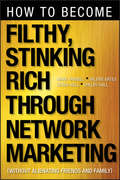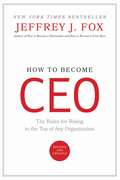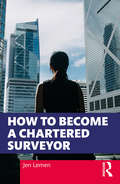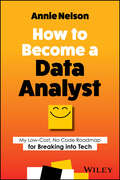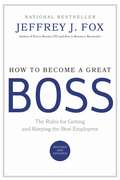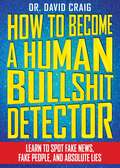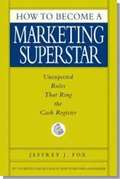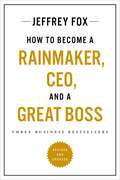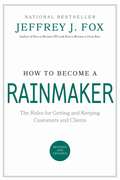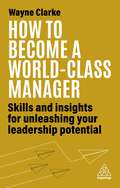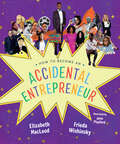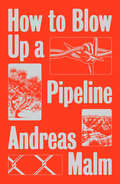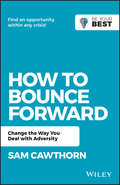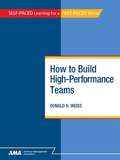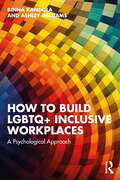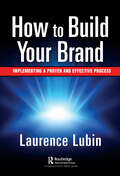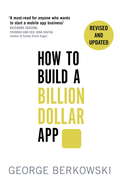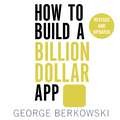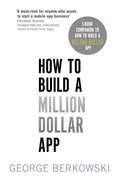- Table View
- List View
How to Become
by Mark Yarnell Derek Hall Valerie Bates Shelby HallA contemporary approach to network marketing--from the author of the million-copy bestseller, Your First Year in Network Marketing This is a book about reality--an unpleasant reality that no one seems to want to address. A large number of the population was hit with substantial loss of income and savings during the recent economic meltdown. Many feel that they have no way to build back their savings in order to retire comfortably and securely. Many now believe that there just isn't enough time left to turn it around. How to Become Filthy, Stinking Rich Through Network Marketing is for those who refuse to accept this nonsense. With such a confusing array of home business opportunities and so many millions caught in the financial meltdown, there has never been a more important time for due diligence and a proven path to follow. In How to Become Filthy, Stinking Rich Through Network Marketing you will learn how to: Select the right networking company based on expert advice and solid criteria Thrive as an entrepreneur Deal with fear, rejection, inertia, and naysayers Build professional habits that drive success Lead, motivate, and serve your team Recruit with rejection-free strategies Learn how to develop an entrepreneurial spirit through network marketing in order to build dramatic prosperity today.
How to Become CEO: The Rules for Rising to the Top of Any Organization
by Jeffrey J. FoxVision, persistence, integrity, and respect for everyone in the workplace--these are all qualities of successful leaders. But Jeffrey J. Fox, the founder of a marketing consulting company, also gives these tips: never write a nasty memo, skip all office parties, and overpay your people. These are a few of his key ways to climb the corporate ladder.messages that are meant to be revisited in your rise to the top.But don't think for a moment that this is a cynical book. Rather, it is one of hard-headed idealism that will empower you to develop the qualities that are required of leaders: vision, persistence, integrity and respect for superiors, subordinates, peers, and self.Anyone looking to climb the corporate ladder will be grateful for Fox's direct, pithy advice-the essentials to follow if you want to reach the top.
How to Become a Chartered Surveyor
by Jen LemenThinking about a career in property or construction? Thinking of becoming of Chartered Surveyor? How to Become a Chartered Surveyor demystifies the process and provides a clear road map for candidates to follow. The book outlines potential pathways and practice areas within the profession and includes the breadth and depth of surveying, from commercial, residential and project management, to geomatics and quantity surveying. Experienced APC assessor and trainer, Jen Lemen BSc (Hons) FRICS, provides invaluable guidance, covering: routes to becoming a Chartered Surveyor, including t-levels, apprenticeships and alternative APC routes such as the Senior Professional, Academic and Specialist assessments areas of professional practice advice for the AssocRICS, APC (MRICS), FRICS and Registered Valuer assessments, including both written and interview elements advice on referrals and appeals how to support candidates, including the role of the Counsellor and Supervisor opportunities for further career progression, including further qualifications and setting up in practice as an RICS regulated firm global perspectives professional ethics for surveyors Written in clear, concise and simple terms and providing practical advice throughout, this book will help candidates to decode and understand the RICS guidance, plan their career and be successful in their journey to become a Chartered Surveyor. It will also be of relevance to academic institutions, employers, school leavers, apprentices, senior professionals, APC Counsellors/Supervisors and careers advisors.
How to Become a Data Analyst: My Low-Cost, No Code Roadmap for Breaking into Tech
by Annie NelsonStart a brand-new career in data analytics with no-nonsense advice from a self-taught data analytics consultant In How to Become a Data Analyst: My Low-Cost, No Code Roadmap for Breaking into Tech, data analyst and analytics consultant Annie Nelson walks you through how she took the reins and made a dramatic career change to unlock new levels of career fulfilment and enjoyment. In the book, she talks about the adaptability, curiosity, and persistence you’ll need to break free from the 9-5 grind and how data analytics—with its wide variety of skills, roles, and options—is the perfect field for people looking to refresh their careers. Annie offers practical and approachable data portfolio-building advice to help you create one that’s manageable for an entry-level professional but will still catch the eye of employers and clients. You’ll also find: Deep dives into the learning journey required to step into a data analytics role Ways to avoid getting lost in the maze of online courses and certifications you can find online—while still obtaining the skills you need to be competitive Explorations of the highs and lows of Annie’s career-change journey and job search—including what was hard, what was easy, what worked well, and what didn’t Strategies for using ChatGPT to help you in your job searchA must-read roadmap to a brand-new and exciting career in data analytics, How to Become a Data Analyst is the hands-on tutorial that shows you exactly how to succeed.
How to Become a Great Boss: The Rules for Getting and Keeping the Best Employees
by Jeffrey J. FoxThe Great Boss Simple Success Formula: Companies Do What the Boss Does Groom 'Em, or Broom 'Em Hire Slow, Fire Fast Don't Be Tired The Rule of the Ds Delegate Down, Down, Down Don't Hire a Dog and Bark Yourself Don't Shoot from the Lip Never Be Little, Never Belittle Listen to Phonies, Fools, and Frauds Don't Check Expense Accounts "Quit" Is for Scrabble® It's Okay to Be QuirkyDid you ever have a great boss? Everyone should have one, but not enough people do. If you're a boss, or hope to become one, or have a less-than-great boss, then this is the book that could change your career--and your life.In times like these, being a great boss can be harder than ever. If you want surprising and useful advice on how to handle the tough stuff--from having to fire a long-time employee to being a new boss with a demoralized team--the stories, observations, and advice contained in this gem of a book will set your feet in the right direction. And if you just want advice on living up to the legend who preceded you in the job, or even ways to emulate someone who was a great boss to you, Jeffrey Fox has gathered anecdotes from some of the mightiest and most respected bosses in America. The bestselling author who brought you How to Become CEO and How to Become a Rainmaker knows the territory about which he speaks.Fox is the master of the counterintuitive angle. For every boss who has implied "I know what's best, that's why I'm the boss," Fox counsels, "Listen to Phonies, Fools, and Frauds" and "Don't Check Expense Accounts." His stories from bosses who have cared equally for employees' lives and the bottom line will inspire you to see that profit counts, but so do camaraderie, motivation, and a great place to work.In a time of considerable corporate downsizing, it's more important than ever for bosses to surround themselves with motivated employees. Jeffrey Fox's How to Become a Great Boss will have a place on the shelves of top brass everywhere who want to remain leaders of their pack.o Become CEO and How to Be a Rainmaker, turns his counter-intuitive eye to the process of being a great boss, and--even more difficult--staying a great boss.
How to Become a Human Bullshit Detector: Learn to Spot Fake News, Fake People, and Absolute Lies
by David CraigAn expert in lie detection teaches you how to uncover the truth.Lying is a normal part of human communication and is sometimes necessary to protect someone’s feelings. At the same time, there are also malicious lies meant to deceive, cheat, and defraud. Especially in today’s world, in which technology, media, and the government have blurred the lines between fact and fiction, you can’t always rely on what comes out of someone’s mouth or what you see on the internet or television. It doesn’t take mind-reading superpowers to be able to tell when someone is lying—but it does take special skills and a little practice. In How to Become a Human Shit Detector, international expert in undercover operations Dr. David Craig provides readers with an easy-to-follow guide on applying lie-detection skills to your everyday life. From the simple skills of bargaining, making a purchase, or dealing with children, to the more serious business of negotiating a contract, identifying infidelity, or understanding lies in politics, Craig delivers simple but effective tips and techniques we can all use to see behind the façade and find our way to the truth. The culmination of more than twenty years of practical criminology and hundreds of hours of academic research, this book is the premier guide to the art of lie-detecting. Split into three parts, the book looks at understanding lies and how to detect lies, and it includes an easy reference section that summarizes all the main points. The mystery of what a person is really thinking is finally unlocked in this fascinating and informative book.
How to Become a Marketing Superstar: Unexpected Rules that Ring the Cash Register
by Jeffrey J. FoxWith more than 600,000 books in print, nationally bestselling author Jeffrey Fox is back to 'outfox the competition'--this time with counterintuitive advice on how to become a marketing genius n his four previous bestselling business books, Jeffrey Fox has helped readers land great jobs and rise to the top of their professions. Now he turns his contrarian eye to marketing through brand building and innovation. Fox's advice is delivered in snappy, to-the-point chapters that zero in on his creative--and often counterintuitive--advice and features such unforgettable fundamentals as: Make a big splash, instead of a lot of little ripples Always have a pipeline to the president Own a market, not a mill The long and short definitions of marketingThere are also provocative 'Instant Marketing Superstar' challenges throughout the book, offering the reader a chance to solve real business problems. In a time of corporate budget cuts, it's more important than ever for all employees to be creative marketers. How to Become a Marketing Superstar is certain to find a place on the shelves of anyone who wants to increase sales in a competitive marketplace.
How to Become a Rainmaker, CEO, and a Great Boss: Three Business Bestsellers
by Jeffrey J. FoxA revised and updated omnibus edition of Jeffrey Fox's three classic business bestsellers, including a foreword and two brand new chapters! For years, business leaders, marketers, salespeople, and entrepreneurs have learned from and relied on the bestselling advice of Jeffrey J. Fox. Now his three most popular works, How to Become a Rainmaker, How to Become CEO, and How to Become a Great Boss, appear fully revised and updated for the first time together. A terrific resource for anyone looking to distinguish themselves in sales—be it books, cars, or real estate—How to Become a Rainmaker offers the opportunity to rise above the competition in any company, in any field. Filled with smart tips given in the Fox signature style, counter-intuitive, controversial, and practiced, this hard-hitting collection of sales advice shows readers how to woo, pursue, and finally win any customer.How to Become CEO teaches anyone how to climb the corporate ladder. Vision, persistence, integrity, and respect for everyone in the workplace—these are all qualities of successful leaders. And Fox brings specific and actionable tips for exemplifying them: never write a nasty memo, skip all office parties, and overpay your people. If you're looking to get to the top, this book is the place to start. If you're a boss, or hope to become one, or have a less-than-great boss, How to Become a Great Boss can change your career—and your life. With surprising and useful advice on how to handle the tough stuff—from having to fire a long-time employee to being a new boss with a demoralized team—the stories, observations, and advice contained in this gem of a book will set your feet in the right direction.
How to Become a Rainmaker: The Rules for Getting and Keeping Customers and Clients
by Jeffrey J. FoxFilled with smart tips given in the Fox signature style, counter-intuitive, controversial, and practiced, this hard-hitting collection of sales advice shows readers how to woo, pursue, and finally win any customer. In witty, succinct chapters, Fox offers surprising, daring, and totally practical wisdom that will help readers rise above the competition in any company in any field. A terrific resource for CEOs, as well as anyone looking to distinguish themselves in sales--be it books, cars, or real estate--How to Become a Rainmaker offers the opportunity to rise above the competition in any company, in any field.nyone who'd like to excel in sales.In HOW TO BECOME A RAINMAKER, Jeffery Fox has written a winning handbook filled with short, pithy advice that will raise some eyebrows and, no doubt, some income levels as readers follow the suggestions to make it rain.
How to Become a Video Game Artist: The Insider's Guide to Landing a Job in the Gaming World
by Sam R. KennedyBecome a Player in the Business of Video Game ArtEvery year video games generate billions of dollars and some of the most dynamic and engaging artwork today. It's an ever-growing field that holds great professional opportunity, but you need the right skills and savvy if you want to stake your claim. In How to Become a Video Game Artist, veteran video game designer Sam R. Kennedy provides the inside track on everything you need to forge a career in the world of video game art. Starting with the basics of game creation and a look at the artistic skills necessary to get started, Kennedy spotlights specific, key roles for creators--from concept artists to character animators to marketing artists and beyond. Each chapter features screenshots from popular video games like Tom Clancy's Ghost Recon and World of Warcraft; interviews with video game art professionals who've worked for top gaming companies like BioWare, Blizzard, and Ubisoft; step-by-step examples of actual game art; and detailed breakdowns of the training and portfolio samples you'll need to make these jobs your own. For anyone who wants to go from gamer to game designer, this book contains all the secrets you'll need to rise to the top of one of the most exciting industries of our time.
How to Become a World-Class Manager: Skills and Insights for Unleashing Your Leadership Potential
by Wayne ClarkeWhether you're an aspiring manager, in middle management or a global executive, gain the skills, insights and confidence you need to become a world-class manager. Over 77% of organizations believe that effective leadership is lacking in the modern workforce. That leaves a huge opportunity for success for anyone who develops their skills to become a world-class manager. This ground-breaking book uncovers the secrets of success through key insights across all sectors and all disciplines of business, from time management and meetings to developing strategies and building a team. As a globally renowned leadership expert, Wayne Clarke brings his wealth of expertise to this book, distilling the key insights and skills from his globally bestselling course. Supported by a range of diverse case studies, How to Become a World-Class Manager will equip you with the skills and insights you need to take your career to new heights and reach the higher echelons of management.
How to Become an Accidental Entrepreneur (Accidental Series #3)
by Frieda Wishinsky Elizabeth MacLeodTake a risk! Find your niche! Get to work! How do entrepreneurs get ideas for a new business and how do they make their businesses thrive? What drives some entrepreneurs to use their ability and wealth to help others pursue their dreams and live better lives? Every entrepreneur has a unique story, but many share qualities that have helped them on their road to achievement. In How to Become an Accidental Entrepreneur readers will meet almost 100 entrepreneurs, such as Stephen Spielberg, Victoria Kisyombe, Oprah Winfrey and Amit Goffer, whose work has made a difference around the world. These entrepreneurs and more used their financial prosperity to help the world by giving donations or setting up charitable organizations. Young readers will discover the fascinating stories of people who turned obstacles into creative actions that allowed them to start new companies and create jobs for others. Praise for other books in the Accidental series: ★ “Engaging and thought-provoking, this book is a treasure trove of inspirational people and ideas." —Canadian Children's Book News, starred review "With many geniuses included and a good deal of space devoted to illustrations, each introduction is limited in length but usefully concise. An informative overview with an upbeat look and a lively text." —Booklist “This volume will inspire readers to conduct further investigation into the movements that excite them, and they might be spurred to stand up and make their voices heard.” —School Library Journal
How to Blow Up a Pipeline
by Andreas MalmProperty will cost us the earthThe science on climate change has been clear for a very long time now. Yet despite decades of appeals, mass street protests, petition campaigns, and peaceful demonstrations, we are still facing a booming fossil fuel industry, rising seas, rising emission levels, and a rising temperature. With the stakes so high, why haven't we moved beyond peaceful protest?In this lyrical manifesto, noted climate scholar (and saboteur of SUV tires and coal mines) Andreas Malm makes an impassioned call for the climate movement to escalate its tactics in the face of ecological collapse. We need, he argues, to force fossil fuel extraction to stop--with our actions, with our bodies, and by defusing and destroying its tools. We need, in short, to start blowing up some oil pipelines.Offering a counter-history of how mass popular change has occurred, from the democratic revolutions overthrowing dictators to the movement against apartheid and for women's suffrage, Malm argues that the strategic acceptance of property destruction and violence has been the only route for revolutionary change. In a braided narrative that moves from the forests of Germany and the streets of London to the deserts of Iraq, Malm offers us an incisive discussion of the politics and ethics of pacifism and violence, democracy and social change, strategy and tactics, and a movement compelled by both the heart and the mind. Here is how we fight in a world on fire.
How to Boost Your Credit Score 100+ Points In 30 Days Without Credit Repair!
by Brian DiezDid you know that you could have credit scores in the low 600's even if you never missed a bill payment in your life? That's because your payment history is only 35% of your credit score. "How to Boost You Credit score 100+ Points Without Credit Repair" will show credit industry secrets for maximizing the other 65%. The best part is you will see real results in just 30 days.
How to Bounce Forward: Change the Way You Deal with Adversity (Be Your Best)
by Sam CawthornHow to transform crisis into success At just 26 years old Sam Cawthorn experienced a serious car accident that resulted in the loss of his arm and was told that he may never walk again. At this critical moment he realised he had an incredible opportunity to create a better life. His experience drove him to uncover the mechanics, tools and strategies to not just bounce back, but to bounce forward and live a greater life with greater focus and greater success. How to Bounce Forward gives you the tools you need to successfully navigate crisis and use it to your advantage.
How to Breathe While Suffocating: A Story Of Overcoming Addiction, Recovering From Trauma, and Healing My Soul
by Bruce W. BrackettLet go of negativity, rediscover your inherent worth, and unlock your true potential How To Breathe While Suffocating is your antidote to the all-too-common tendency to surrender, giving up on your life’s ambitions. You don’t have to give up! For anyone who has gotten caught in the trap of “I can’t do it,” this book reminds you that you are enough, you possess value, and your unique ability to engage with the world can and will get you to where you want to be. Through simple positive affirmations, unflinching first-person stories, and insightful analysis, author Bruce W. Brackett helps you focus on the positive and keep moving forward. Society today is experiencing a hidden pandemic of loneliness, disconnection, and resistance to recovery. After the life-altering shutdowns of COVID-19, many of us have simply remained in shutdown mode. This book uses universal concepts, expressed through engaging narrative, to help you grapple with issues like mental health, isolation, gender identity, disconnection, and the overwhelming sense of negativity for our collective future. By the end, you’ll learn to turn it around and get back to the business of living. The message of How to Breathe When Suffocating is simple—spread love, inhabit joy, and embrace the power of positivity. · Gain the inspiration you need to seize your potential, find confidence, and step into your authentic self · Change your outlook on life with simple slogans and mantras for developing a healthier, more positive attitude · Realize that you aren’t alone in your struggle, and see how others are finding the strength to move forward in difficult times · Read the compelling story of one man who overcame insurmountable odds and found salvation from negativity and self-doubt After a two-decade healing journey of intensive trauma therapy, psychiatric treatment, and rehab, Bruce W. Brackett has emerged a survivor. Anyone in the midst of their own healing journey will resonate with benefit from his lived experience, portrayed here with intimate vulnerability and universal appeal.
How to Build High-Performance Teams
by Donald H. WeissHere’s a step-by-step process to recruit, empower and lead teams. How to Build High-Performance Teams focuses on the how-to keys of team-building—from recruiting the right team members to truly empowering them with authority and responsibility for their decisions and performance. You’ll understand how to build trust, confidence, and group work skills, balancing and fine-tuning the team process as you go. You'll learn how to: • Build and manage teams that live up to their promise of higher productivity and greater problem-solving ability • Maximize team productivity by encouraging group discussion and problem-solving • Overcome organizational, management and employee barriers to teamwork • Manage interpersonal conflicts among team members
How to Build LGBTQ+ Inclusive Workplaces: A Psychological Approach
by Binna Kandola Ashley WilliamsBringing together the latest research with practical insights from the authors’ professional experience, this important book provides a context for the conversations that are needed within organisations and offers practical guidance towards action that can be taken to improve the working life of LGBTQ+ employees.The book begins by asking how we got here. It outlines the development of stigma towards the LGBTQ+ community from both a historical and psychological perspective before going on to explore the ways in which societal attitudes manifest in the work environment. It then looks specifically at LGBTQ+ experiences in the workplace, covering discrimination and exclusion and their impact at both an individual and organisational level before taking an intersectional view of LGBTQ+ identity, and particularly how it interacts with race, disability and age. The book then provides clear and practical guidance on how to build an LGBTQ+ inclusive workplace, covering organisational policy and culture, leadership and allyship. Throughout, the authors use case studies to demonstrate how to implement policies across a range of regions and offer strategies to minimise homophobic and discriminatory attitudes.Taking a psychological approach to this important topic, the book is essential reading for all those looking to build and sustain welcoming and inclusive workplaces across all sectors. It will also be of interest to students in psychology, management and human resources studying workplace attitudes and culture.
How to Build Your Brand: Implementing a Proven and Effective Process
by Laurence LubinBrand Strategy is the most important marketing talent. A 2020 Gartner Survey of 400 CMO's cited Brand Strategy as the most needed skill, more valuable than analytics, UX, digital commerce. Previous books on the subject analyze the qualities and characteristics of well-regarded brands. What these books don't offer are the "how to's" of branding. This book empowers readers by teaching them the author's unique, time-tested Success Model, and step-by-step, repeatable method for successful brand building. After reading this insightful book, you will learn how to: Develop "big picture" insight that inspires big brand ideas Use imagery to understand the fundamental human values that give our life meaning as well as learn about the feelings that reveal our hopes and dreams. Develop highly motivating brand concepts that link to our values and aspirations. Create the tactical roadmap to implement the concepts. The author clearly shares the: Success Model that defines the world's most successful brands. Case studies that demonstrate the Model in action.Step-by-step method to implement the model. The evidence -- scientific and psychological --.that supports the model and method. Essentially, this book empowers readers to become skilled brand builders enabling them to succeed personally, socially, and professionally.
How to Build Your Brand: Implementing a Proven and Effective Process
by Laurence LubinBrand Strategy is the most important marketing talent. A 2020 Gartner Survey of 400 CMO's cited Brand Strategy as the most needed skill, more valuable than analytics, UX, digital commerce. Previous books on the subject analyze the qualities and characteristics of well-regarded brands. What these books don't offer are the "how to's" of branding. This book empowers readers by teaching them the author's unique, time-tested Success Model, and step-by-step, repeatable method for successful brand building. After reading this insightful book, you will learn how to: Develop "big picture" insight that inspires big brand ideas Use imagery to understand the fundamental human values that give our life meaning as well as learn about the feelings that reveal our hopes and dreams. Develop highly motivating brand concepts that link to our values and aspirations. Create the tactical roadmap to implement the concepts. The author clearly shares the: Success Model that defines the world's most successful brands. Case studies that demonstrate the Model in action.Step-by-step method to implement the model. The evidence -- scientific and psychological --.that supports the model and method. Essentially, this book empowers readers to become skilled brand builders enabling them to succeed personally, socially, and professionally.For more information on this book, please visit: www.howtobuildyourbrand.net
How to Build a Billion Dollar App: Discover the Secrets of the Most Successful Entrepreneurs of Our Time
by George BerkowskiTHE ULTIMATE GUIDE TO BUILDING AN APP-BASED BUSINESS - NOW REVISED AND UPDATED FOR 2017'A must read for anyone who wants to start a mobile app business' Riccardo Zacconi, founder and CEO King Digital (maker of Candy Crush Saga) 'A fascinating deep dive into the world of billion-dollar apps. Essential reading for anyone trying to build the next must-have app' Michael Acton Smith, Founder and CEO, Mind Candy Apps have changed the way we communicate, shop, play, interact and travel and their phenomenal popularity has presented possibly the biggest business opportunity in history.In How to Build a Billion Dollar App, serial tech entrepreneur George Berkowski gives you exclusive access to the secrets behind the success of the select group of apps that have achieved billion-dollar success.Berkowski draws exclusively on the inside stories of the billion-dollar app club members, including Instagram, Whatsapp, Snapchat, Candy Crush and Uber to provide all the information you need to create your own spectacularly successful mobile business. He guides you through each step, from an idea scribbled on the back of an envelope, through to finding a cofounder, building a team, attracting (and keeping) millions of users, all the way through to juggling the pressures of being CEO of a billion-dollar company (and still staying ahead of the competition).If you've ever dreamed of quitting your nine to five job to launch your own company, you're a gifted developer, seasoned entrepreneur or just intrigued by mobile technology, How to Build a Billion Dollar App will show you what it really takes to create your own billion-dollar, mobile business.
How to Build a Billion Dollar App: Discover the secrets of the most successful entrepreneurs of our time
by George BerkowskiTHE ULTIMATE GUIDE TO BUILDING AN APP-BASED BUSINESS 'A must read for anyone who wants to start a mobile app business' Riccardo Zacconi, founder and CEO King Digital (maker of Candy Crush Saga) 'A fascinating deep dive into the world of billion-dollar apps. Essential reading for anyone trying to build the next must-have app' Michael Acton Smith, Founder and CEO, Mind Candy Apps have changed the way we communicate, shop, play, interact and travel and their phenomenal popularity has presented possibly the biggest business opportunity in history.In How to Build a Billion Dollar App, serial tech entrepreneur George Berkowski gives you exclusive access to the secrets behind the success of the select group of apps that have achieved billion-dollar success.Berkowski draws exclusively on the inside stories of the billion-dollar app club members, including Instagram, Whatsapp, Snapchat, Candy Crush and Uber to provide all the information you need to create your own spectacularly successful mobile business. He guides you through each step, from an idea scribbled on the back of an envelope, through to finding a cofounder, building a team, attracting (and keeping) millions of users, all the way through to juggling the pressures of being CEO of a billion-dollar company (and still staying ahead of the competition).If you've ever dreamed of quitting your nine to five job to launch your own company, you're a gifted developer, seasoned entrepreneur or just intrigued by mobile technology, How to Build a Billion Dollar App will show you what it really takes to create your own billion-dollar, mobile business.
How to Build a Billion Dollar App: Discover the secrets of the most successful entrepreneurs of our time
by George BerkowskiTHE ULTIMATE GUIDE TO BUILDING AN APP-BASED BUSINESS 'A must read for anyone who wants to start a mobile app business' Riccardo Zacconi, founder and CEO King Digital (maker of Candy Crush Saga) 'A fascinating deep dive into the world of billion-dollar apps. Essential reading for anyone trying to build the next must-have app' Michael Acton Smith, Founder and CEO, Mind Candy Apps have changed the way we communicate, shop, play, interact and travel and their phenomenal popularity has presented possibly the biggest business opportunity in history.In How to Build a Billion Dollar App, serial tech entrepreneur George Berkowski gives you exclusive access to the secrets behind the success of the select group of apps that have achieved billion-dollar success.Berkowski draws exclusively on the inside stories of the billion-dollar app club members, including Instagram, Whatsapp, Snapchat, Candy Crush and Uber to provide all the information you need to create your own spectacularly successful mobile business. He guides you through each step, from an idea scribbled on the back of an envelope, through to finding a cofounder, building a team, attracting (and keeping) millions of users, all the way through to juggling the pressures of being CEO of a billion-dollar company (and still staying ahead of the competition).If you've ever dreamed of quitting your nine to five job to launch your own company, you're a gifted developer, seasoned entrepreneur or just intrigued by mobile technology, How to Build a Billion Dollar App will show you what it really takes to create your own billion-dollar, mobile business.
How to Build a Billion Dollar App: E-Book Companion To How To Build A Billion Dollar App
by George BerkowskiApps have changed the way we communicate, shop, play, interact and travel and their phenomenal popularity has presented possibly the biggest business opportunity in history. In How to Build a Billion Dollar App, serial tech entrepreneur George Berkowski - one of the minds behind the internationally successful taxi hailing app Hailo - gives you exclusive access to the secrets behind the success of the select group of apps that have achieved billion-dollar success. Berkowski draws exclusively on the inside stories of the billion-dollar app club members, including Instagram, Whatsapp, Snapchat, Candy Crush, Square, Viber, Clash of Clans, Angry Birds, Uber and Flipboard to provide all the information you need to create your own spectacularly successful mobile business. He guides you through each step, from an idea scribbled on the back of an envelope, through to finding a cofounder, building a team, attracting (and keeping) millions of users, all the way through to juggling the pressures of being CEO of a billion-dollar company (and still staying ahead of the competition). If you've ever dreamed of quitting your nine to five job to launch your own company or you're a gifted developer, seasoned entrepreneur or just intrigued by mobile technology, How to Build a Billion Dollar App will show you what it really takes to create your own billion-dollar, mobile business.
How to Build a Billion-Dollar Business: On Purpose. For Profit. With Passion.
by Radek SaliDiscover the strategies and secrets behind a billion-dollar Australian success story In How to Build a Billion-Dollar Business, former Swisse CEO Radek Sali unpacks how his unique approach to product, people, and branding took Swisse Wellness from an Australian favourite to a blockbuster brand that sold for $2.1 billion. At the heart of How to Build a Billion-Dollar Business is Radek’s passion for finding purpose in work. This book shares inspiring real-world strategies, stories, and insights on how to build a business that makes an astounding profit — but more than that, how to build a business that also does good. A successful business is not just about profit: it’s about culture. Inside, you’ll learn how to develop a business plan, foster loyalty and innovation in your team, build a thriving workplace culture rooted in values, and attract and retain customers who believe in your product and your mission. Build a culture of trust, openness, and respect — in your organisation as well as with your customer. Get timely and valuable insights on what it means to build a flexible business and a sustainable, responsible brand. Learn how to drive growth and sales reach by connecting with customers and driving an aspirational product or service. Build a business that makes a real social or environmental difference in your community, one that gives back and supports growth and wellness for all. From his early career days to his success as a serial entrepreneur and ethical investor, Radek Sali shares a blueprint for discovering what drives you and making your business goals a reality. How to Build a Billion-Dollar Business is a handbook for business owners everywhere, showing you how to succeed in creating positive change in your business and in the world.
